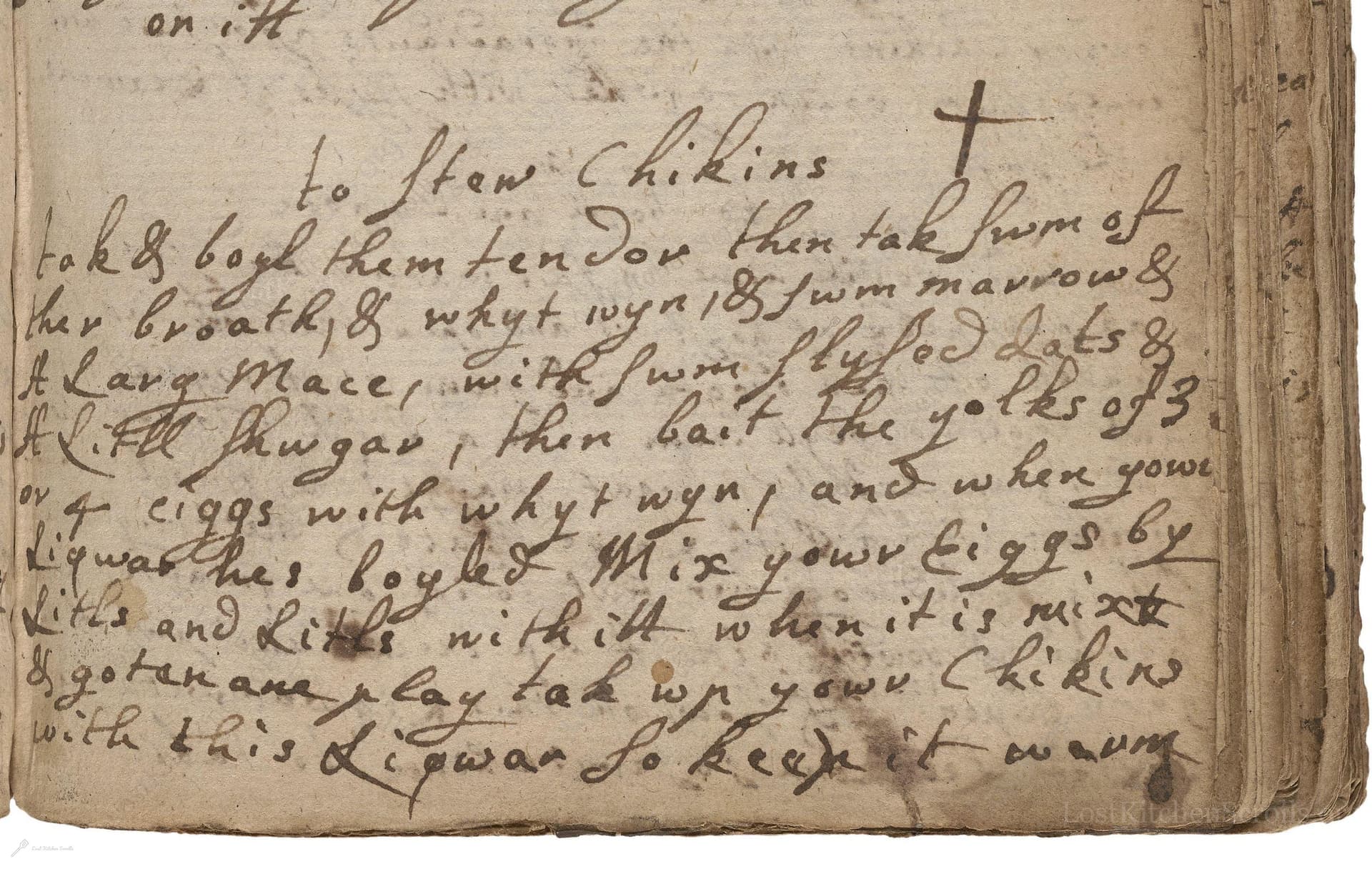To Stew Chikins
From the treasured pages of Medicinal, household and cookery recipes
Unknown Author

To Stew Chikins
"tak & boyll them tendor than tak swm of the broth, & whyt wyn, & swm marrow, & a larg Mace, with swm slysed dats, & a littl shwgar, then batt the yolkes of 3 or 4 ciggs with whyt wyn, and when yowr Liqwar hes boyled Mix yowr Eiggs by litts and Little with itt when it is mixt goten ane play tak wp yowr Chikins with this Liqwar so keep itt warm"
Note on the Original Text
The recipe, written in early modern English with variable spelling, reflects the informal and oral nature of culinary instructions at the time. Punctuation and measurements are sparse—cooks were expected to know how much was 'enough.' Odd spellings like 'boyll,' 'whyne,' and 'ciggs' (for eggs) were common, and instructions relied on the reader’s practical knowledge. Lists of ingredients and steps flow together, requiring modern cooks to parse and adapt for clarity and precision.

Title
Medicinal, household and cookery recipes (1675)
You can also click the book image above to peruse the original tome
Writer
Unknown
Era
1675
Publisher
Unknown
Background
A delightful glimpse into 17th-century kitchens, this manuscript serves up a smorgasbord of recipes and culinary wisdom, capturing the flavors and flair of early modern cooking.
Kindly made available by
Folger Shakespeare Library
This recipe hails from the late 17th century (circa 1650–1700), a time of burgeoning culinary refinement in England. Dishes combining chicken, wine, sweet spices, and dried fruits were popular among the upper classes, reflecting both the influence of continental cooking and a taste for luxury ingredients like spices and sugar. The use of marrow, mace, and sugar speaks to a period when savory-sweet combinations were widely enjoyed at the great tables. Recipes were typically transmitted in manuscript household books—such as the one referenced here—used by women to record tried and true preparations for family and guests.

In the original kitchen, a large cauldron or pot would be suspended over the hearth fire to boil the chicken. The sauce would be prepared in a pan or small pot, likely of brass or tinned copper, using wooden spoons for stirring. Eggs might be beaten with a birch twig whisk, and wine poured from stoneware jugs. The final dish would be kept warm near the fire or within a hearth oven until serving.
Prep Time
15 mins
Cook Time
1 hr
Servings
6
We've done our best to adapt this historical recipe for modern kitchens, but some details may still need refinement. We warmly welcome feedback from fellow cooks and culinary historians — your insights support the entire community!
Ingredients
- 1 whole chicken (about 3 1/3 lb), jointed, or several small chickens
- Water, as needed to cover chicken
- 1 cup dry white wine, plus 3 tablespoons extra
- 2 oz beef marrow (or 1.5 oz unsalted butter as substitute)
- 1 whole mace blade
- 4–5 dates, thinly sliced
- 2 teaspoons sugar
- 3 or 4 egg yolks
- Salt, to taste (optional for modern palates)
Instructions
- Begin by simmering a whole chicken (about 3 1/3 lb) or several smaller chickens in enough water to cover, until the meat is tender—about 45–60 minutes.
- Remove the chickens, reserving about 2 cups of the broth.
- In a clean saucepan, combine the reserved broth, 1 cup dry white wine, 2 oz beef marrow (or substitute with 1.5 oz unsalted butter), 1 whole blade of mace, 4–5 sliced dates, and 2 teaspoons sugar.
- Bring this mixture to a gentle boil.
- In a seperate bowl, whisk 3 or 4 egg yolks with 3 tablespoons additional white wine.
- When the broth mixture is hot (but not boiling vigorously), whisk in the egg yolk mixture gradually, stirring constantly so the eggs don't scramble.
- Once the sauce is thickened and smooth, return the chicken peices to the pot, coating them well in this rich liquid.
- Keep warm, and serve immediately—perhaps with sops of bread to catch the luxurious sauce.
Estimated Calories
400 per serving
Cooking Estimates
You will need about 15 minutes to prepare the chicken and ingredients. The chicken simmers for about 1 hour. This recipe serves 6 people, each serving has around 400 calories.
As noted above, we have made our best effort to translate and adapt this historical recipe for modern kitchens, taking into account ingredients nowadays, cooking techniques, measurements, and so on. However, historical recipes often contain assumptions that require interpretation.
We'd love for anyone to help improve these adaptations. Community contributions are highly welcome. If you have suggestions, corrections, or cooking tips based on your experience with this recipe, please share them below.
Join the Discussion
Rate This Recipe
Dietary Preference
Occasions

Den Bockfisch In Einer Fleisch Suppen Zu Kochen
This recipe hails from a German manuscript cookbook compiled in 1696, a time whe...

Die Grieß Nudlen Zumachen
This recipe comes from a rather mysterious manuscript cookbook, penned anonymous...

Ein Boudain
This recipe comes from an anonymous German-language manuscript cookbook from 169...

Ein Gesaltzen Citroni
This recipe, dating from 1696, comes from an extensive anonymous German cookbook...
Browse our complete collection of time-honored recipes



